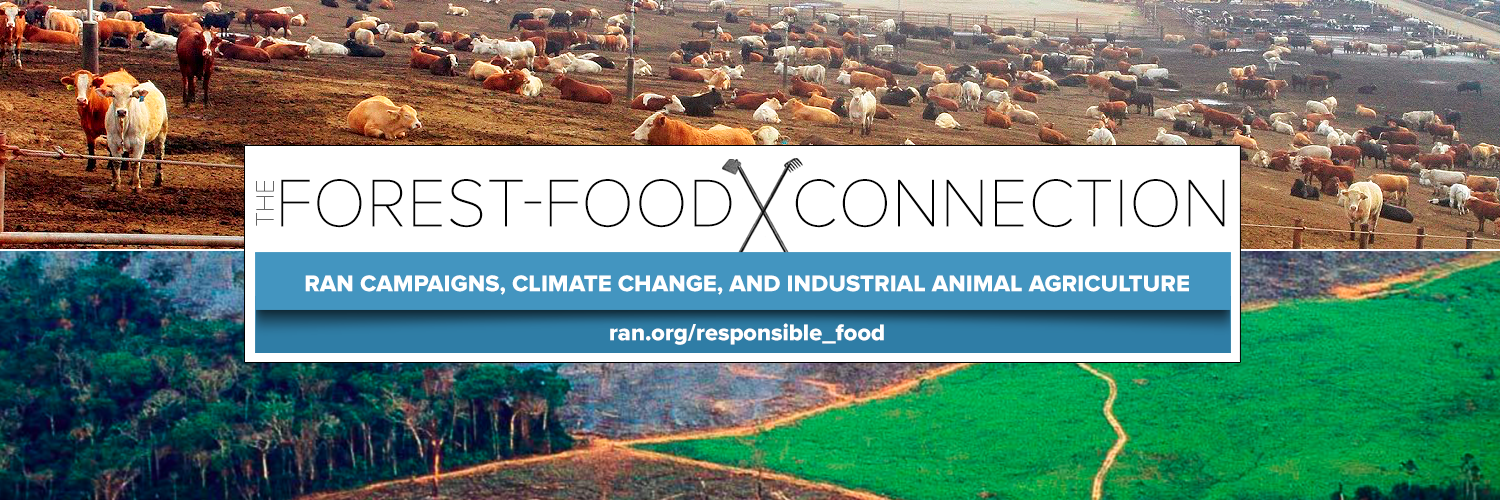How Are Animals Raised In Industrial Meat Production
In the midst of an 8 twelvemonth RAN campaign on Conflict Palm Oil that'south even so going strong, the vast majority of people I speak to sympathize the connections betwixt consumer demand for palm oil, deforestation and species extinction. The earth is finally waking upwards to the ways in which palm oil is threatening the very survival of amazing animals like orangutans, tigers and elephants that depend on the fragile tropical rainforests of Republic of indonesia and Malaysia. But very few people are talking about our insatiable appetite for animal products and how it'southward driving some of the biggest, near egregious corporations in the world to wipe out biodiversity as nosotros sleep.
The livestock sector is now the leading cause of reduction of biodiversity according to the Food and Agriculture Organization of the United nations (FAO) [76] and a recent commodity in Environment Mag. [77] Aye, that's right. All those cows, pigs, sheep, and chickens raised for nutrient and dairy products.
A contempo report by the Zoological Social club of London, in concert with WWF International, claims that in the by twoscore years 52% of all the globe's wild animals has disappeared, with agriculture, urban evolution, and food free energy production identified as the major threats. [78] Studies find that a third of biodiversity loss is linked to livestock product, due to deforestation and land conversion, overgrazing and deposition of grassland, and desertification. [79] A significant portion of this degradation is due to the trend in skyrocketing growth of monoculture animal feed crops. About half of birds worldwide are currently threatened by this destruction. [lxxx]
At that place may exist no other unmarried act that has a bigger impact on the planet than the raising of livestock, reports Time Magazine. [81]
Livestock production currently takes upward about 30% of the planet's water ice-complimentary land and 75% of agricultural land globally (lxxx% of US ag state). [82] In the Usa, 260 million acres have been cleared for grazing and feed, which is 3 times the entire National Parks system. [83] Raising livestock has too helped create the system of monocrops and pesticides that'south killing off pollinators and other wildlife in the US.
Due to the USDA'due south failure to fairly regulate genetically engineered (GE) crops and the increasing use of pesticides needed to grow them, recent studies have documented a dramatic decline in pollinators and soil fertility. [84] In 2013 the European Commission (EC) imposed a two-year ban on a form of pesticides known as "neonicotinoids," at present the globe'south well-nigh widely used type of insecticide. In the U.South., neonicotinoids are currently used on almost 95% of corn and canola crops, the majority of cotton wool, sorghum, and sugar beets, nearly one-half of all soybeans, and on the vast majority of fruit and vegetable crops. [85] These pesticides impact all species that chew a establish, sip its sap, drink its nectar, and swallow its pollen or fruit; these impacts pour through an entire ecosystem, weakening its stability. [86]
ii,4-D is one of the ingredients in the notorious "agent orangish" used past the US armed services to spray and defoliate big areas of Vietnam, and linked to major public health impacts, both on Vietnamese civilians and The states soldiers treatment the chemicals. Chemical companies pushing 2,4-D resistant crops as a quick gear up to the epidemic of glyphosate-resistant weeds are making matters worse. [87]
While there is of course huge variability farm-to-subcontract, mainstream grazing practices also destroy native vegetation, damage soil and stream banks, and contaminate waterways. The FAO determined that 70% of grazing land in drier climates is at present considered degraded. In the Usa, grazing is the most destructive grade of land utilise in the West, contributing to the demise of 22% of endangered species. On public lands solitary, over 175 already threatened and endangered species are further threatened by the presence of livestock. [88]
Louie Psihoyos of Oceanic Preservation Order makes the instance in the riveting documentary Racing Extinction that the biggest cistron influencing mass extinction is converting natural habitat into land for food. [89]
As humans go along to spread our tentacles of development further and further into vast reaches of the planet, for everyday products like potato chips fried in palm oil or a steak from a moo-cow that was raised in a feedlot, nosotros must realize that we're quickly approaching a tipping point. It would behoove us to deeply consider our footprint on this planet and how significantly we are interfering with the natural rest of world's ecosystem health, biodiversity, and climate.
[76] FAO, Livestock'south Long Shadow. Environmental Issues and Options (Rome, Italy: Food and Agriculture Organization of the United Nations, 2006).
[77] http://world wide web.environmentmagazine.org/Archives/Back%20Issues/2015/May-June%202015/meat_abstract.html
[78] WWF, Living Planet Report 2014. Species and Spaces, People and Places (Gland, Switzerland: 2014).
[79] H. Westhoek et al., The Protein Puzzle. The Consumption and Product of Meat, Dairy and Fish in the European Marriage (The Hague, The Netherlands: PBL Netherlands Ecology Assessment Agency, 2011).
[80] http://world wide web.environmentmagazine.org/Archives/Back%20Issues/2015/May-June%202015/meat_abstract.html
[81] http://science.time.com/2013/12/xvi/the-triple-whopper-ecology-bear on-of-global-meat-production/ ad
[82] http://www.fao.org/newsroom/en/News/2006/1000448/index.html
[83] http://world wide web.takeextinctionoffyourplate.com/earth-friendly_diet.html
[84] http://civileats.com/2015/01/27/the-next-phase-of-genetic-engineering-a-inundation-of-new-crops-evading-environmental-regulation/
[85] http://e360.yale.edu/feature/declining_bee_populations_pose_a_threat_to_global_agriculture/2645/
[86] http://www.tfsp.info/worldwide-integrated-assessment/
[87] http://www.jstor.org/stable/x.1525/bio.2012.62.1.12?seq=ane#page_scan_tab_contents
[88] USDI-BLM, USDA-Wood Service. 1995. Rangeland Reform '94 Last Ecology Affect Statement. USDI-BLM. Washington, DC: 26
[89] https://www.racingextinction.com/

Source: https://www.ran.org/the-understory/how_does_meat_production_and_consumption_impact_biodiversity/
Posted by: avishispers1979.blogspot.com

0 Response to "How Are Animals Raised In Industrial Meat Production"
Post a Comment